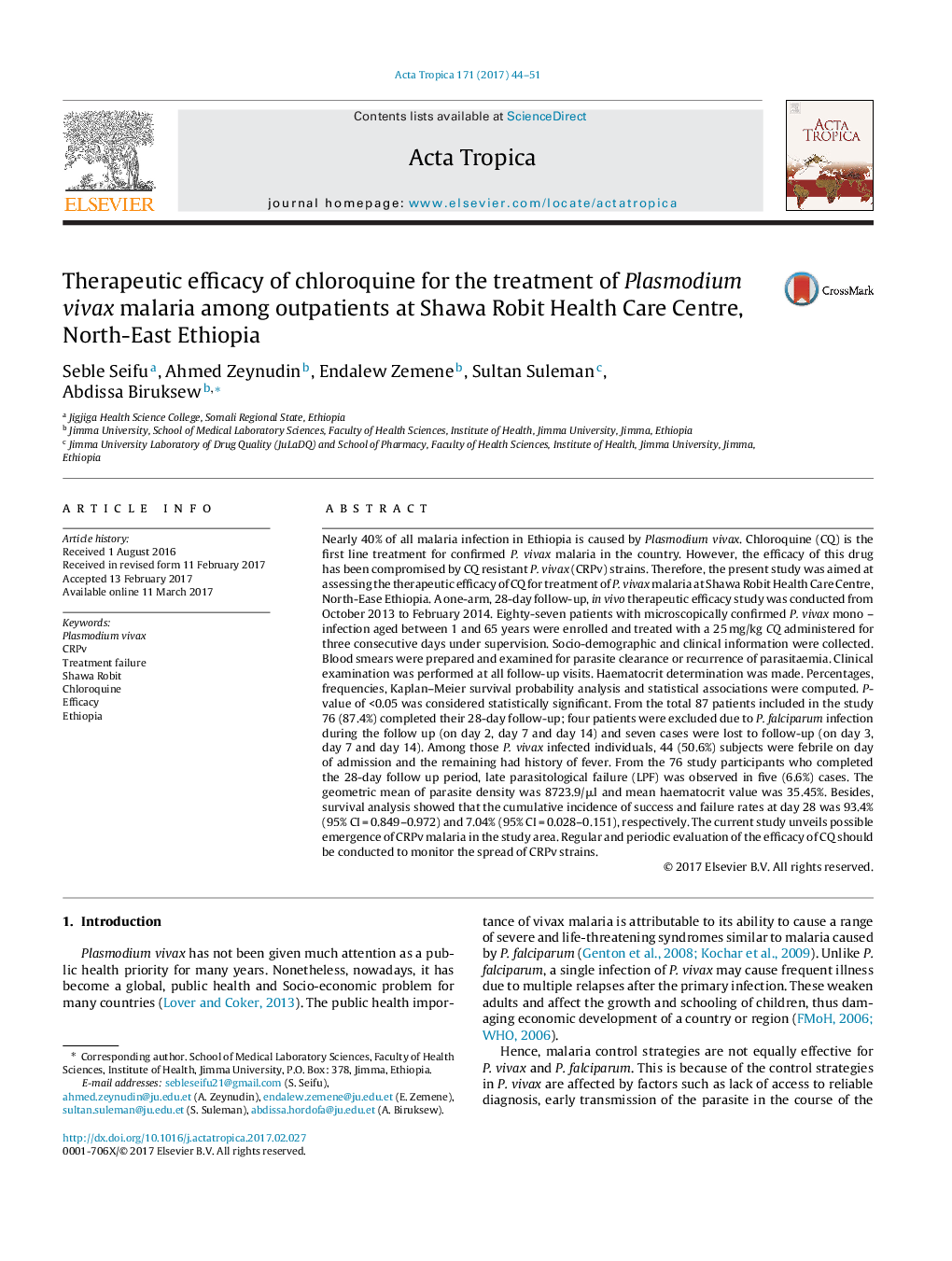| کد مقاله | کد نشریه | سال انتشار | مقاله انگلیسی | نسخه تمام متن |
|---|---|---|---|---|
| 5671159 | 1592753 | 2017 | 8 صفحه PDF | دانلود رایگان |
- A single-arm, 28-day follow-up in vivo CQ therapeutic efficacy study was conducted.
- Eighty-seven patients with microscopically confirmed P. vivax mono-infection aged between 1 and 65 years were enrolled.
- Patients were treated with a 25Â mg/kg CQ administered for three consecutive days under supervision.
- Forty-four (50.6%) of the study participants were febrile on day of admission and the remaining had history of fever.
- Late parasitological failure (LPF) was observed in five (6.6%) cases during the 28 day follow up period.
- Possible emergence of CRPv malaria in the study area was indicated.
- Regular and periodic evaluation of the efficacy of CQ should be conducted to monitor the spread of CRPv strains.
Nearly 40% of all malaria infection in Ethiopia is caused by Plasmodium vivax. Chloroquine (CQ) is the first line treatment for confirmed P. vivax malaria in the country. However, the efficacy of this drug has been compromised by CQ resistant P. vivax (CRPv) strains. Therefore, the present study was aimed at assessing the therapeutic efficacy of CQ for treatment of P. vivax malaria at Shawa Robit Health Care Centre, North-Ease Ethiopia. A one-arm, 28-day follow-up, in vivo therapeutic efficacy study was conducted from October 2013 to February 2014. Eighty-seven patients with microscopically confirmed P. vivax mono - infection aged between 1 and 65 years were enrolled and treated with a 25 mg/kg CQ administered for three consecutive days under supervision. Socio-demographic and clinical information were collected. Blood smears were prepared and examined for parasite clearance or recurrence of parasitaemia. Clinical examination was performed at all follow-up visits. Haematocrit determination was made. Percentages, frequencies, Kaplan-Meier survival probability analysis and statistical associations were computed. P-value of <0.05 was considered statistically significant. From the total 87 patients included in the study 76 (87.4%) completed their 28-day follow-up; four patients were excluded due to P. falciparum infection during the follow up (on day 2, day 7 and day 14) and seven cases were lost to follow-up (on day 3, day 7 and day 14). Among those P. vivax infected individuals, 44 (50.6%) subjects were febrile on day of admission and the remaining had history of fever. From the 76 study participants who completed the 28-day follow up period, late parasitological failure (LPF) was observed in five (6.6%) cases. The geometric mean of parasite density was 8723.9/μl and mean haematocrit value was 35.45%. Besides, survival analysis showed that the cumulative incidence of success and failure rates at day 28 was 93.4% (95% CI = 0.849-0.972) and 7.04% (95% CI = 0.028-0.151), respectively. The current study unveils possible emergence of CRPv malaria in the study area. Regular and periodic evaluation of the efficacy of CQ should be conducted to monitor the spread of CRPv strains.
Journal: Acta Tropica - Volume 171, July 2017, Pages 44-51
